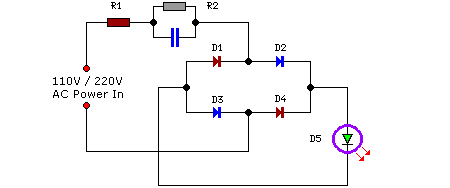
Mains Operated LED Circuit

This is a straightforward and effective LED circuit that can be powered directly from an AC mains supply ranging from 100 volts to 230 volts. The circuit can serve as a mains power indicator or a night lamp. Resistors R1 and R2, along with capacitor C1, provide essential current limiting. The circuit is designed to be robust against voltage spikes and surges.
The described LED circuit operates on the principle of using a series combination of resistors and a capacitor to limit the current flowing through the LED. The circuit is connected directly to the AC mains, which allows it to illuminate the LED without the need for a transformer or additional power supply components.
In this configuration, R1 and R2 are chosen based on the desired brightness of the LED and the maximum current rating of the LED. Typically, these resistors are valued to allow a safe current to flow through the LED, which is usually rated for around 20 mA for standard applications. The capacitor C1 serves a dual purpose: it not only helps in current limiting but also provides a phase shift that allows the LED to operate effectively with the alternating current.
The immunity to voltage spikes and surges is achieved through the proper selection of components and their ratings. The resistors must be able to withstand the maximum voltage that may appear across them, while the capacitor should have a voltage rating significantly higher than the maximum expected AC voltage to avoid breakdown.
This LED circuit can be utilized in various applications, including as a power indicator for appliances, a night lamp for low-light environments, or as a simple visual alert for various electronic devices. Its simplicity and effectiveness make it a popular choice for both hobbyists and professionals in the field of electronics.Here is a simple and powerful LED circuit that can be operated directly from the AC 100 volt to AC 230 Volts mains supply. The circuit can be used as mains power locator or night lamp etc.. The resistor R1,R2 and capacitor C1 provides necessary current limiting. The circuit is sufficiently immune against voltage spikes and surges.. 🔗 External reference
The described LED circuit operates on the principle of using a series combination of resistors and a capacitor to limit the current flowing through the LED. The circuit is connected directly to the AC mains, which allows it to illuminate the LED without the need for a transformer or additional power supply components.
In this configuration, R1 and R2 are chosen based on the desired brightness of the LED and the maximum current rating of the LED. Typically, these resistors are valued to allow a safe current to flow through the LED, which is usually rated for around 20 mA for standard applications. The capacitor C1 serves a dual purpose: it not only helps in current limiting but also provides a phase shift that allows the LED to operate effectively with the alternating current.
The immunity to voltage spikes and surges is achieved through the proper selection of components and their ratings. The resistors must be able to withstand the maximum voltage that may appear across them, while the capacitor should have a voltage rating significantly higher than the maximum expected AC voltage to avoid breakdown.
This LED circuit can be utilized in various applications, including as a power indicator for appliances, a night lamp for low-light environments, or as a simple visual alert for various electronic devices. Its simplicity and effectiveness make it a popular choice for both hobbyists and professionals in the field of electronics.Here is a simple and powerful LED circuit that can be operated directly from the AC 100 volt to AC 230 Volts mains supply. The circuit can be used as mains power locator or night lamp etc.. The resistor R1,R2 and capacitor C1 provides necessary current limiting. The circuit is sufficiently immune against voltage spikes and surges.. 🔗 External reference





